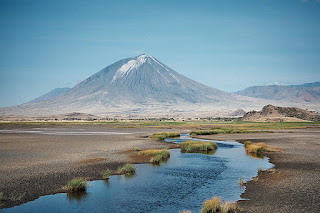April 30, 2018
Carbonatites are strange igneous rocks made up mostly of
carbonates – common minerals like calcite, calcium carbonate. Igneous rocks
that solidify from molten magma usually are high-temperature rocks containing
lots of silicon which results in lots of quartz, feldspars, micas, and
ferro-magnesian minerals in rocks like granite and basalt. Carbonatites
crystallize from essentially molten calcite, and that’s really unusual.
Most carbonatites are intrusive, meaning they solidified
within the earth, and it wasn’t until 1960 that the first carbonatite volcano
erupted in historic times, proving that they form from cooling magma. The
eruption at Ol Doinyo Lengai in Tanzania occurred on a branch of the East
African Rift System, and most carbonatites are associated with these breaks in
continental crust where eventually a new ocean may form.
 |
| Mt Lengai, Tanzania, photo by Clem23 (Creative Commons License - source) |
A simple and early interpretation of carbonatites was that
they represented melting of limestone, but geochemical data indicate that they
really do come from primary igneous material that probably originated in the
mantle. Exactly how they form is debated, in part because they are so rare, but
one idea is that they result from special cases of differentiation within more
common magmas, or maybe an example of certain chemicals – the carbonates – separating
out in an unusual way.
Another unusual aspect of carbonatites is the minerals
associated with the dominant calcite. It’s common to get rare-earth compounds,
tantalum, thorium, titanium, and many other minerals that are unusual in high
concentrations in other settings. The Mountain Pass rare-earth deposit in
California, once the largest producer of rare earths in the world, is in a
Precambrian carbonatite. Rare earths are used in lots of modern technologies,
including turbines for wind energy, batteries in electric car motors, cell
phones, solar cells, and eyeglasses.
Rare earths are also produced from the Mt. Weld carbonatite
in Western Australia, but it’s more famous for its tantalum, an element that’s
vital in capacitors
Mark as Played
Popular Podcasts
Stuff You Should Know
If you've ever wanted to know about champagne, satanism, the Stonewall Uprising, chaos theory, LSD, El Nino, true crime and Rosa Parks, then look no further. Josh and Chuck have you covered.
Dateline NBC
Current and classic episodes, featuring compelling true-crime mysteries, powerful documentaries and in-depth investigations. Follow now to get the latest episodes of Dateline NBC completely free, or subscribe to Dateline Premium for ad-free listening and exclusive bonus content: DatelinePremium.com
The Breakfast Club
The World's Most Dangerous Morning Show, The Breakfast Club, With DJ Envy, Jess Hilarious, And Charlamagne Tha God!